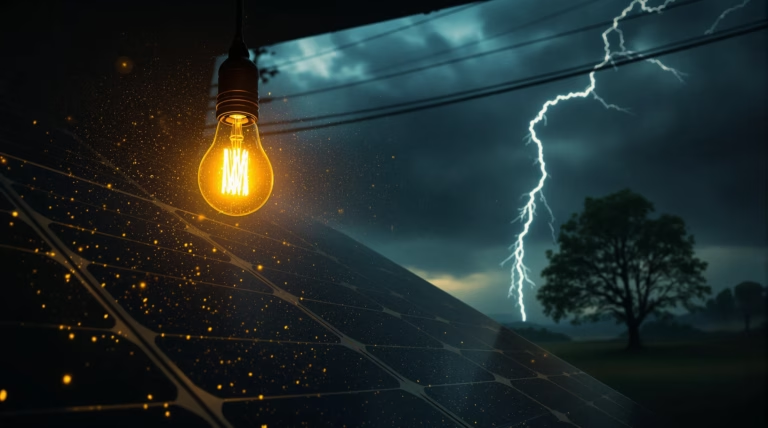Solar Panels vs Electricity: A Comprehensive Comparison
Making the switch from traditional electricity to solar power is a significant decision that impacts both your wallet and the environment. As energy costs surge and environmental awareness grows, understanding the key differences between these power sources becomes crucial for making an informed choice. Let’s explore how these energy solutions compare across various aspects.
Understanding Solar Panels and Traditional Electricity
The fundamental difference between solar panels and traditional electricity lies in their energy sources and distribution methods. While solar power harnesses renewable energy from the sun, traditional electricity relies on finite fossil fuels processed through complex networks. With electricity prices rising by over 4.3% in 2021, many homeowners are seeking alternatives that offer both cost stability and environmental benefits.
What Are Solar Panels?
Solar panels are sophisticated photovoltaic devices that transform sunlight directly into usable electricity. A complete solar power system includes:
- Photovoltaic cells (typically silicon-based) that generate electric current
- Inverters for converting DC power to AC power
- Mounting equipment for secure installation
- Battery storage systems for energy retention
- Connection components for grid integration
How Traditional Electricity Works
Traditional electricity generation follows a centralized model with several key components:
- Power plants burning fossil fuels or using nuclear fission
- Steam-driven turbines connected to generators
- High-voltage transmission lines
- Substations with voltage-reducing transformers
- Local distribution networks
Cost Comparison: Solar Panels vs Traditional Electricity
| Aspect | Solar Panels | Traditional Electricity |
|---|---|---|
| Initial Cost | $15,000-$30,000 | No upfront cost |
| Long-term Expenses | Minimal maintenance costs | Continuous monthly bills |
| Property Value Impact | +4.1% average increase | No impact |
Initial Investment and Installation Costs
Solar panel systems require a significant upfront investment, ranging from $15,000 to $30,000 before incentives. This cost encompasses panels, inverters, mounting hardware, wiring, and professional installation. Traditional electricity, while requiring no initial investment, subjects users to perpetual payments and increasing rates.
Long-term Savings and Financial Benefits
The financial advantages of solar power become evident over time:
- Payback period of 7-10 years
- Potential savings of $40,000+ over system lifetime
- Net metering income opportunities
- Average $15,000 increase in home resale value
- Protection against rising utility rates
Environmental Impact: Solar Energy vs Electricity
When comparing solar energy to traditional electricity, the environmental impact difference is stark and significant. Traditional electricity generation, primarily reliant on fossil fuels, contributes to 25% of global greenhouse gas emissions. Solar energy, in contrast, produces zero emissions during operation, making it one of the cleanest power sources available today.
Solar panels’ initial environmental investment, known as ’embodied carbon footprint,’ is typically recovered within 1-4 years of operation. After this period, they generate clean energy for their remaining 25-30 year lifespan, continuously replacing electricity from polluting sources and playing a crucial role in global carbon emission reduction efforts.
Reducing Carbon Footprint with Solar Energy
- Eliminates 3-4 tons of carbon emissions annually per residential system
- Equivalent to planting over 100 trees each year
- Eliminates 5-8% transmission losses common in centralized power generation
- Reduces need for environmentally destructive mining and drilling
- Creates a more resilient energy ecosystem through distributed generation
Pollution and Climate Change Concerns with Electricity
| Environmental Impact | Traditional Electricity |
|---|---|
| Emissions | 2.6 billion tons of CO2 annually (U.S. electricity sector) |
| Air Pollutants | Mercury, sulfur dioxide, nitrogen oxides, particulate matter |
| Water Usage | 41% of all U.S. freshwater withdrawals |
| Additional Impacts | Habitat destruction, water contamination, methane leaks |
Maintenance and Longevity of Solar Panels
Solar panel systems stand out for their minimal maintenance requirements and impressive durability. Unlike traditional electricity infrastructure, these systems operate reliably with little intervention, primarily due to their lack of moving parts. Modern solar installations typically maintain efficient electricity production for 25-30 years or more, with many manufacturers offering performance warranties guaranteeing 80% capacity after 25 years.
Routine Maintenance Requirements
- Periodic cleaning to remove dust, pollen, and debris
- Natural cleaning through rainfall in many regions
- Annual visual inspections for damage assessment
- Performance monitoring through integrated software
- Maintenance costs: $150-$300 annually
Expected Lifespan and Durability
Quality solar panels demonstrate exceptional durability, withstanding decades of harsh weather conditions including extreme temperatures, hail, snow, and high winds. Premium panels undergo extensive testing and hold certifications for impact resistance and wind tolerance exceeding 140 mph. This robust engineering enables modern solar systems to maintain efficiency for 25-30 years, with many continuing to perform well beyond their warranty periods.
- Annual degradation rate: 0.5% or less
- Performance after 25 years: 87.5% of original capacity
- Wind resistance: Up to 140+ mph
- Weather tolerance: Extreme temperatures, hail, snow
- System components lifespan: 25-30 years for panels, 10-15 years for inverters
Financial Incentives and Tax Breaks for Solar Energy
Solar energy adoption offers substantial financial advantages beyond monthly utility savings. Through a combination of federal, state, and local utility incentives, homeowners can significantly reduce their initial investment and accelerate their return on investment. These incentives can lower installation costs by 30-50% in many areas, making solar energy increasingly accessible to average homeowners.
Federal and State Tax Credits
| Incentive Type | Benefit |
|---|---|
| Federal Investment Tax Credit (ITC) | 30% of total installation costs through 2032 |
| State Tax Credits | $1,000 – $5,000 additional savings |
| Property Tax Exemptions | No increased property tax assessment |
| Performance Incentives | Payment for generated electricity |
Other Financial Incentives
- Solar Renewable Energy Certificates (SRECs): $200-$400 annual revenue per kilowatt
- Utility company rebates: Up to $500 per kilowatt installed
- Low-interest solar loans with zero down payment options
- PACE financing: 10-20 year terms with property tax assessment
- Transferable financing options for property sales







